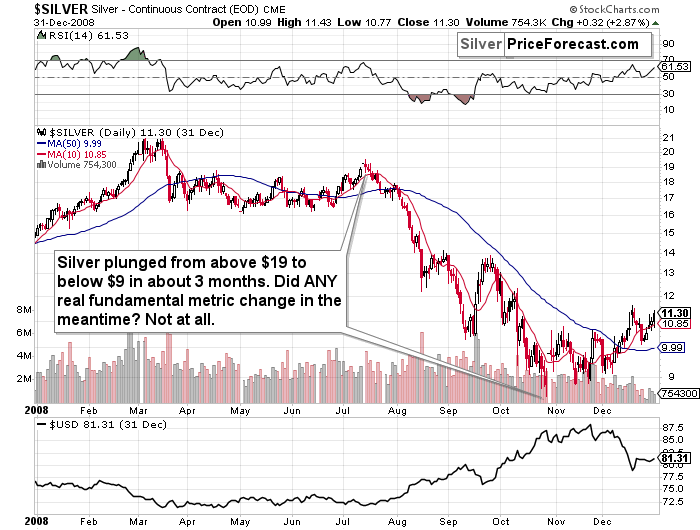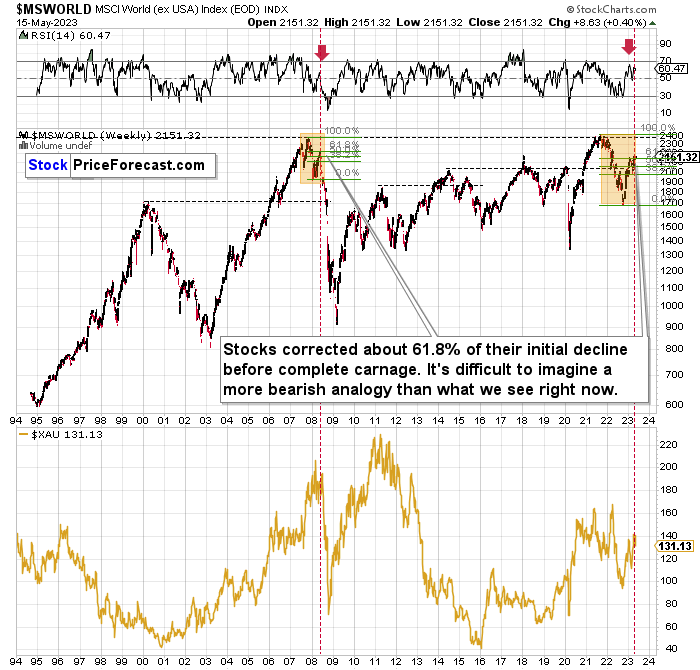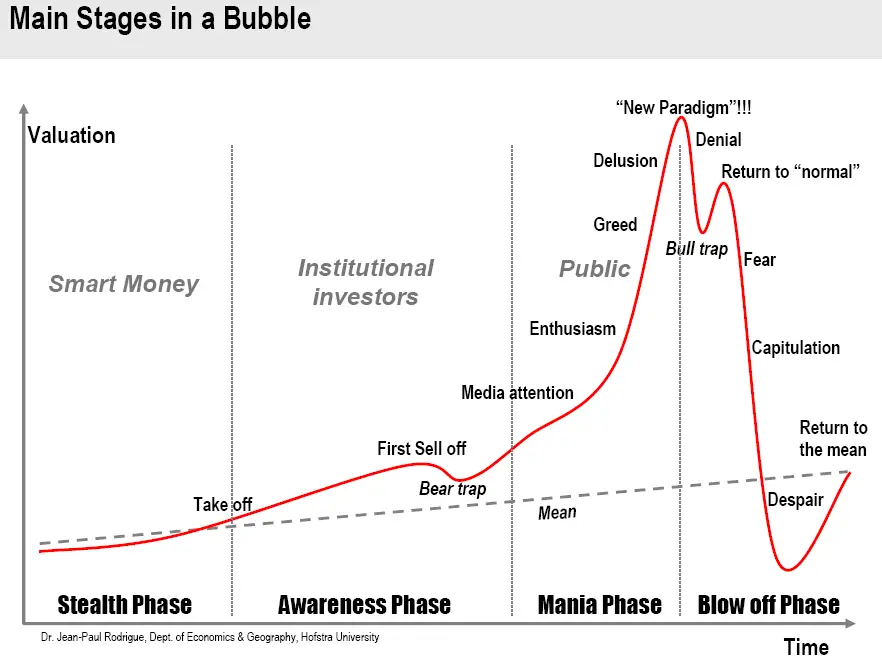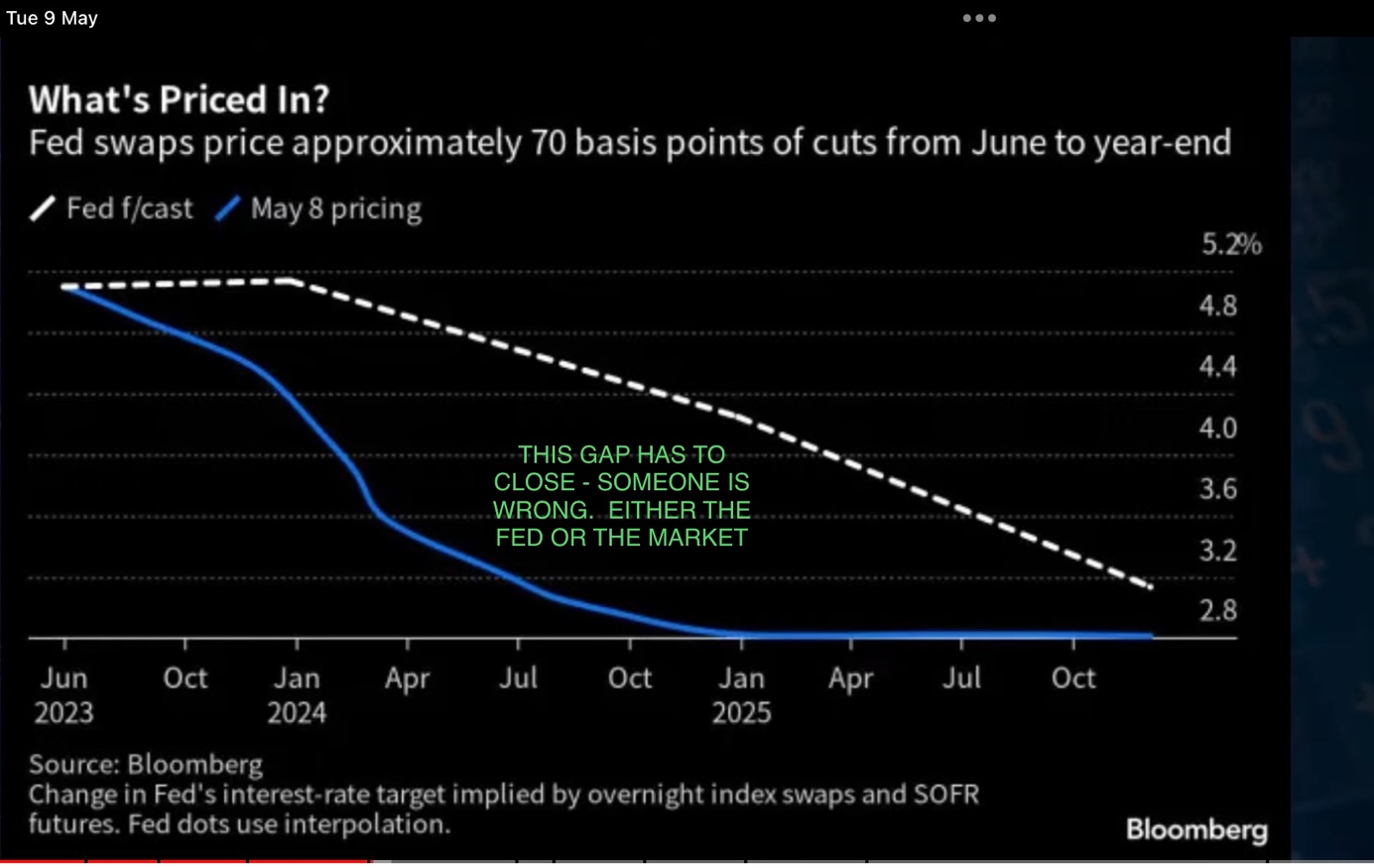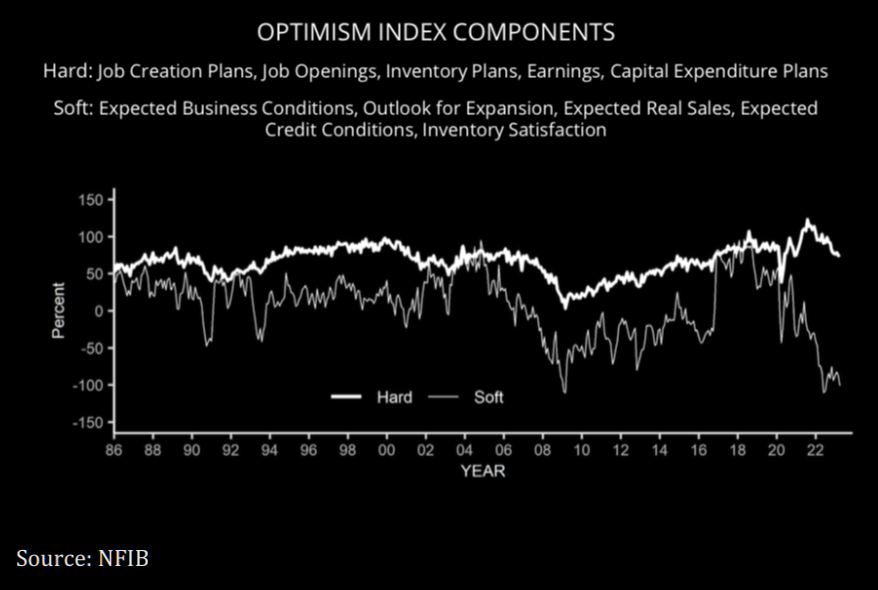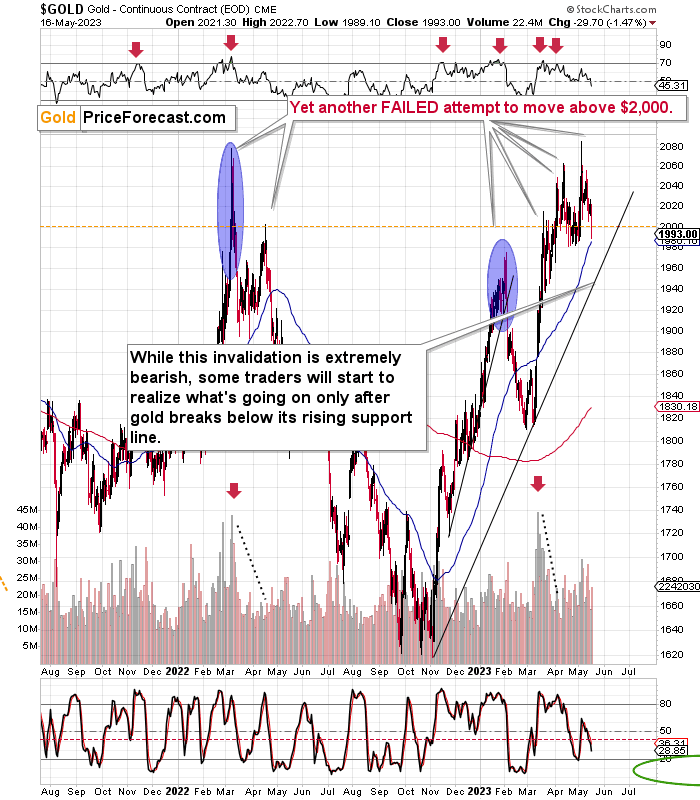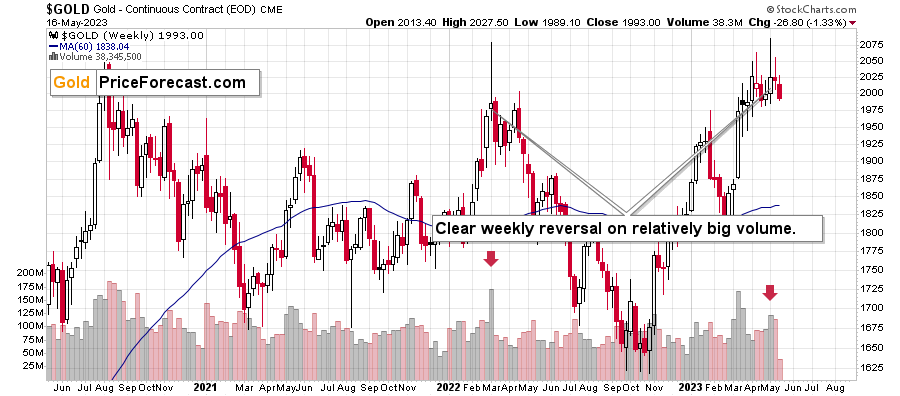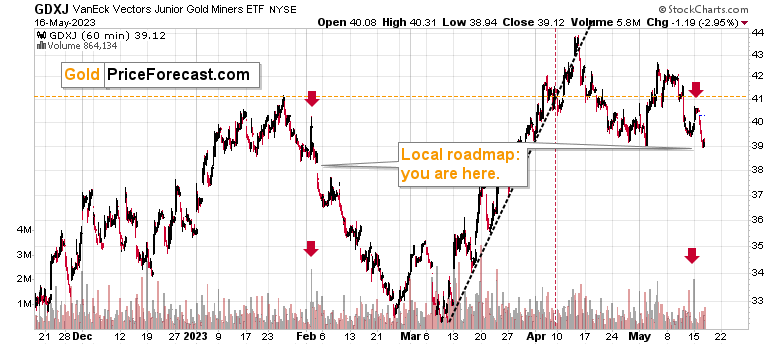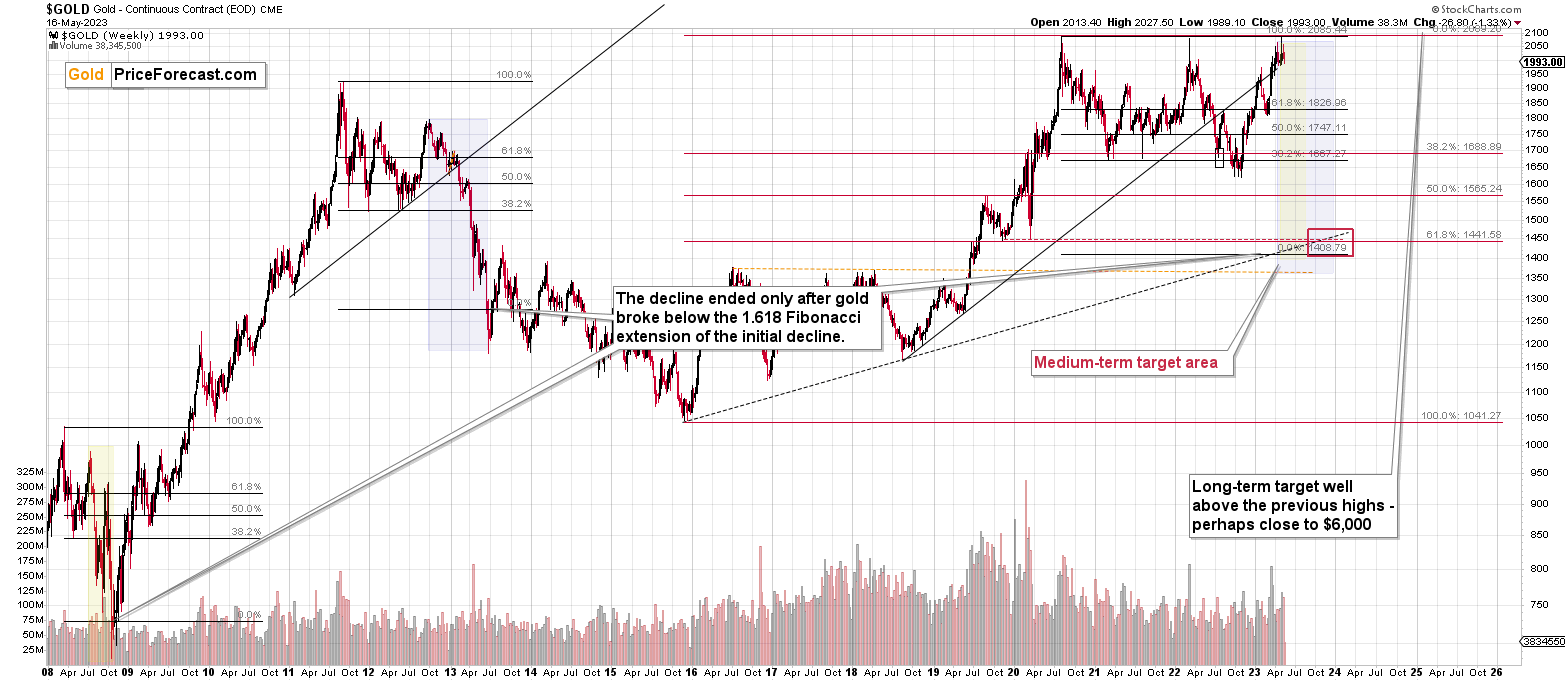Briefly: in our opinion, full (300% of the regular position size) speculative short positions in junior mining stocks are justified from the risk/reward point of view at the moment of publishing this Alert.
Some might consider an additional (short) position in the FCX.
Gold price didn’t soar todamoon. It didn’t soar at all, yesterday. Instead, it moved back below $2,000 failing the attempt to break above it once more.
Before moving to charts, I would like to quote a comment from below one of my previous Gold Trading Alerts along with my reply. It’s from four days ago (Hi, Eddy! :) ),
We are betting against 90% of the gold experts. When was the last time they got it all right? Or when was the last time they got it all wrong?
The first reply (Hi, Alex! :) ) was:
In 2022 when the Ukraine war was going to send gold to $3,000 ;)
And to that, I added the following:
“Please remember this quote :) "90% of gold experts were bullish in May 2023, when gold was trading above $2,030". It will be interesting to see how it matures in the following part of this year :)”
I’m putting it out here, so that more people can see it.
Let me tell you a secret… Experts are people too :). And people get emotional. It’s easy to be bullish close to the tops because looking back, one sees rising prices. However, that’s the only way that prices can arrive to their top, isn’t it?
Of course, I’m not saying that price increases are essentially bearish. But a rally is just that – something that already happened – it’s not bullish. “Bullish” or “bearish” are words used to describe expectations regarding the future, and “rally” or “decline” are words used to describe something that already happened. One is about the future, the other is about the past.
And while analyzing past scenarios, looking for analogies and seeing how they related to the current situation is indeed a way to create forecasts, this process is much more complex than just stating that what happened recently to the price itself is now going to happen again.
There’s an entire discipline called “technical analysis” along with its multiple sub-disciplines like cyclical analysis, fractal analysis, Elliott Wave Theory, and so on, that is applied in order to arrive with price forecasts.
Naturally, that’s on top of the fundamental analysis that includes its sub-disciplines too, like demographics, geopolitics and so on. There are myriads of things that one takes into account while making a forecast – or at least that one should take into account while making a forecast.
And yet… It’s easiest to just get “infused” with the current emotional sentiment, which means being bullish after a rally and/or close to tops, and being bearish after a decline and/or close to bottoms.
Also, different types of analysis apply to different timeframes. Fundamentals are important with regard to the following years, but are not really important with regard to medium term and they are rather irrelevant in case of the short term.
Silver provides an awesome example. Remember the 2008 slide in silver?
Silver plunged from above $19 to below $9 in about 3 months. Did ANY real fundamental metric change in the meantime? Not at all.
Did the aboveground silver supply change meaningfully?
No.
Did silver become useless because scientists found some sort of substitutes?
No. Nothing really affected the supply/demand dynamics at that time. And yet, silver declined profoundly.
Is the fundamental situation in silver truly spectacular right now?
Please look at the above chart once again.
The fundamental situation in silver can remain spectacular and its price can be cut in half in a matter of couple of months regardless of that.
Are there multiple reasons for gold to move much higher now and in the coming years? And even more of them with regard to silver? Sure there are! In fact, I expect to see both metals higher in the coming years!
And what does this tell us about the possibility of gold and silver to plunge in an extreme manner in the following months? ABSOLUTELY NOTHING.
Just like silver was able to plunge from above $19 to below $9 in about 3 months in 2008, the entire precious metals market can slide this year, especially if the stock market declined just like it did in 2008.
Oh wait, the situation in the stock markets around the world is currently almost exactly like it was in 2008… With the exception that now it’s even more bearish, because this time the initial decline was bigger.
Back in 2008, stocks corrected about 61.8% of their initial decline before complete carnage. That’s exactly what happened recently. It's difficult to imagine a more bearish analogy than what we see right now.
Ok, there’s one extra analogy – the problems in the banking sector. We saw that in 2008 and we saw it recently as well.
As stocks slide, the precious metals sector, especially junior mining stocks are likely to slide with them. The lower part of the above chart features the XAU Index, which is a proxy for both gold and silver stocks – senior producers. The GDXJ is a bit more volatile, so the odds are that if XAU declines, the GDXJ will decline even more. And since the former decline from above 180 to below 80 in 2008, something truly epic (and profitable for those positioned correctly) is likely in the cards.
Again, this is regardless of the (generally positive in the long run) fundamental situation. Just because something is a good reason for gold / silver / mining stocks to move higher, it doesn’t mean that it’s a good reason for the above to rally now or soon. It could be a reason for those markets to move higher in the following years and something that won’t prevent the market’s decline in the meantime.
To be honest, I don’t blame either my fellow colleagues for getting emotional about the market situation and I don’t blame anyone that got “overly emotional” while commenting and arguing about the outlook. In fact, in my world the concept of blame doesn’t even exist. Besides, I really do think that deep down, everyone is good. We’re all human and it’s easy to get carried away by all sorts of emotional triggers.
And the current market juncture makes it very difficult to stay calm and objective. After all, we are very likely in the “return to normal” stage.
That’s when the vast majority of market participants expect the previously unsustainable rally to be continued, even though much has changed and it’s already a different stage of the market. It’s no longer a bull market.
I’m writing about the stock market here, but the emotionality spreads to other markets as well. That’s most likely why people are not reacting to the massive increases in real interest rates as much as they “should”.
The current expectations regarding the Fed’s interest rate decisions also fall in line. Here’s a chart that Simon just shared in the comment feed below one of the recent Gold Trading Alerts:
Market’s expectations are MUCH more dovish and bullish for stocks, than Fed’s. “Don’t fight the Fed” doesn’t apply now?
And that’s Fed’s forecast, which assumes that inflation will come back down. If it does – real interest rates move higher. If it doesn’t, the Fed will need to keep raising rates. Which means that real interest rates are likely to move higher anyway. Either way, the implications for the precious metals market – and for stocks – are bearish for the following months.
Also, while I’m writing about the Fed. Please note that Jerome Powell is anything but direct. In my opinion, he really wants to avoid the blame for the carnage that's likely to hit the general stock market. When the plunge happens, he doesn't want to be the one that triggers it, but rather someone that tries to prevent it.
The disillusionment will be painful for many.
Here’s another chart from the comments below one of the recent Gold Trading Alerts (thanks, Steven):
Steven’s comment on the above chart was:
I came across this interesting chart of the Optimism Index Components, which I thought was worth sharing with you. The reason I am sharing this is to highlight another similarity to 2008. If you look at the chart, you can see the massive gap between the expectations of a hard landing vs. a soft landing. I noticed that prior to the Global Financial Crisis (GFC), the gap was also wide, but then the gap closed as investors adjusted their expectations on the economy. It feels like we are in a similar situation, as you pointed out a few days ago when you discussed the "Return to Normal" phase.
(…)
The gap between soft and hard inputs is getting very wide.
I added the following to the above:
I agree with your interpretation of this chart. Those "in the know" look at the leading indicators and can read the signs before they become apparent. Back in 2008, the markets plunged, when the "hard" indicators started to decline profoundly and moved to new lows - following the "soft" ones.
While the soft indicators are below their 2020 lows, the hard indicators are far from them. It looks like a massive decline is still ahead.
All the above-mentioned things are connected. The common denominator is the emotional stage of market participants. And it all points to much lower stock values ahead, leading to lower precious metals and – in particular! – junior mining stock values ahead.
Those are all complex matters, but sometimes the best way to handle complexity is through simplicity.
And there are fewer more straightforward things than seeing an invalidation of a breakout above a very important price level.
That’s what just happened in gold.
Instead of breaking above the previous all-time (nominal) highs, gold price invalidated the move above the all-important $2,000 level. It happened not just in intraday terms, but also in terms of the daily closing prices. In layman’s terms – it was a big deal.
It was nothing surprising, though. At least if you’ve been following my analyses for some time now.
Gold was after not just one profound weekly reversal, but after two weekly reversals. This was an extremely bearish combination, and yesterday’s move back below $2,000 is a normal – and initial – consequence of those technical developments.
Markets have been ignoring rising real interest rates for a long time, but with the previous high being reached, it seems that this short-term upswing is over. The move back below $2,000 is just the first step on a huge road to much lower price levels.
When the next step arrives (and it could be soon), and gold moves below its rising support line (visible on the previous chart), many will only then start to realize that the trend changed. And at those times, junior miners will likely already be trading at much lower price levels.
Please note that the GDXJ has not only invalidated its breakout above the early-2023 highs, but the way in which they performed recently is very similar to what we saw in early February.
In fact, on Monday (May 15), I wrote the following:
Namely, the volume on which the GDXJ ETF (a proxy for junior mining stocks) moved higher in the final hour of Friday’s trading was huge. When we saw something like that in a previous similar situation (after a bigger rally), that meant that the big slide was about to start, regardless of the immediate-term follow-up.
The immediate-term follow-up was alike as well. The GDXJ shot up very briefly, to decline some more shortly thereafter.
Yesterday it stopped at the previous monthly low, but based on the similarity to early 2023, it seems that another big move lower is about to start. Gold futures are down in today’s pre-market trading, so the odds are that GDXJ will decline one more time today. And when it does, it’s likely to kick the door wide open to bigger declines.
It’s difficult to stay the course in this (particularly emotional) stage of the bear market in stocks (profits from the short position in the FCX make it more pleasant, though), but it’s also the most profitable thing to do for many. The best time to prepare for the declines is not after the huge decline is halfway done – it’s before that move takes place. Right now, it’s still early.
Also, if things get hot and an intraday update is required, I’ll keep my Gold Trading Alert subscribers informed.
Overview of the Upcoming Part of the Decline
- It seems that the recent – and probably final – corrective upswing in the precious metals sector is over.
- If we see a situation where miners slide in a meaningful and volatile way while silver doesn’t (it just declines moderately), I plan to – once again – switch from short positions in miners to short positions in silver. At this time, it’s too early to say at what price levels this could take place and if we get this kind of opportunity at all.
- I plan to switch from the short positions in junior mining stocks or silver (whichever I’ll have at that moment) to long positions in junior mining stocks when gold / mining stocks move to their 2020 lows (approximately). While I’m probably not going to write about it at this stage yet, this is when some investors might consider getting back in with their long-term investing capital (or perhaps 1/3 or 1/2 thereof).
- I plan to return to short positions in junior mining stocks after a rebound – and the rebound could take gold from about $1,450 to about $1,550, and it could take the GDXJ from about $20 to about $24. In other words, I’m currently planning to go long when GDXJ is close to $20 (which might take place when gold is close to $1,450), and I’m planning to exit this long position and re-enter the short position once we see a corrective rally to $24 in the GDXJ (which might take place when gold is close to $1,550).
- I plan to exit all remaining short positions once gold shows substantial strength relative to the USD Index while the latter is still rallying. This may be the case with gold prices close to $1,400 and GDXJ close to $15 . This moment (when gold performs very strongly against the rallying USD and miners are strong relative to gold after its substantial decline) is likely to be the best entry point for long-term investments, in my view. This can also happen with gold close to $1,400, but at the moment it’s too early to say with certainty.
- The above is based on the information available today, and it might change in the following days/weeks.
You will find my general overview of the outlook for gold on the chart below:
Please note that the above timing details are relatively broad and “for general overview only” – so that you know more or less what I think and how volatile I think the moves are likely to be – on an approximate basis. These time targets are not binding nor clear enough for me to think that they should be used for purchasing options, warrants, or similar instruments.
Letters to the Editor
Please post your questions in the comments feed below the articles, if they are about issues raised within the article (or in the recent issues). If they are about other, more universal matters, I encourage you to use the Ask the Community space (I’m also part of the community), so that more people can contribute to the reply and enjoy the answers. Of course, let’s keep the target-related discussions in the premium space (where you’re reading this).
Summary
To summarize, we recently took profits from the additional FCX trade (right before the trend reversed!) and the current short position in it is VERY profitable as well.
The short position in junior mining stocks is – in my view – poised to become very profitable in the following weeks.
Things might appear chaotic in the precious metals market right now, but based on the analogy to the previous crises (2020 and 2008), it’s clear that gold, miners, and other markets are pretty much doing the same thing all over again.
The implications of this “all over” are extremely bearish for junior mining stocks. Back in 2008, at a similar juncture, GDX’s price was about to be cut in half in about a month! In my opinion, while the decline might not be as sharp this time, it’s likely to be enormous anyway and very, very, very profitable.
If I didn’t have a short position in junior mining stocks, I would be entering it now.
As always, we'll keep you – our subscribers – informed.
To summarize:
Trading capital (supplementary part of the portfolio; our opinion): Full speculative short positions (300% of the full position) in junior mining stocks are justified from the risk to reward point of view with the following binding exit profit-take price levels:
Mining stocks (price levels for the GDXJ ETF): binding profit-take exit price: $26.13; stop-loss: none.
Alternatively, if one seeks leverage, we’re providing the binding profit-take levels for the JDST (2x leveraged). The binding profit-take level for the JDST: $13.87; stop-loss for the JDST: none.
For-your-information targets (our opinion; we continue to think that mining stocks are the preferred way of taking advantage of the upcoming price move, but if for whatever reason one wants / has to use silver or gold for this trade, we are providing the details anyway.):
Silver futures downside profit-take exit price: $17.83 (stop-loss: none)
SLV profit-take exit price: $16.73 (stop-loss: none)
ZSL profit-take exit price: $32.97 (stop-loss: none)
Gold futures downside profit-take exit price: $1,743 (stop-loss: none)
HGD.TO – alternative (Canadian) 2x inverse leveraged gold stocks ETF – the upside profit-take exit price: $10.97 (stop-loss: none due to vague link in the short term with the U.S.-traded GDXJ)
HZD.TO – alternative (Canadian) 2x inverse leveraged silver ETF – the upside profit-take exit price: $25.47 (stop-loss: none)
///
Optional / additional trade idea that I think is justified from the risk to reward point of view:
Short position in the FCX with $27.13 as the short-term profit-take level.
Long-term capital (core part of the portfolio; our opinion): No positions (in other words: cash)
Insurance capital (core part of the portfolio; our opinion): Full position
Whether you’ve already subscribed or not, we encourage you to find out how to make the most of our alerts and read our replies to the most common alert-and-gold-trading-related-questions.
Please note that we describe the situation for the day that the alert is posted in the trading section. In other words, if we are writing about a speculative position, it means that it is up-to-date on the day it was posted. We are also featuring the initial target prices to decide whether keeping a position on a given day is in tune with your approach (some moves are too small for medium-term traders, and some might appear too big for day-traders).
Additionally, you might want to read why our stop-loss orders are usually relatively far from the current price.
Please note that a full position doesn't mean using all of the capital for a given trade. You will find details on our thoughts on gold portfolio structuring in the Key Insights section on our website.
As a reminder - "initial target price" means exactly that - an "initial" one. It's not a price level at which we suggest closing positions. If this becomes the case (as it did in the previous trade), we will refer to these levels as levels of exit orders (exactly as we've done previously). Stop-loss levels, however, are naturally not "initial", but something that, in our opinion, might be entered as an order.
Since it is impossible to synchronize target prices and stop-loss levels for all the ETFs and ETNs with the main markets that we provide these levels for (gold, silver and mining stocks - the GDX ETF), the stop-loss levels and target prices for other ETNs and ETF (among other: UGL, GLL, AGQ, ZSL, NUGT, DUST, JNUG, JDST) are provided as supplementary, and not as "final". This means that if a stop-loss or a target level is reached for any of the "additional instruments" (GLL for instance), but not for the "main instrument" (gold in this case), we will view positions in both gold and GLL as still open and the stop-loss for GLL would have to be moved lower. On the other hand, if gold moves to a stop-loss level but GLL doesn't, then we will view both positions (in gold and GLL) as closed. In other words, since it's not possible to be 100% certain that each related instrument moves to a given level when the underlying instrument does, we can't provide levels that would be binding. The levels that we do provide are our best estimate of the levels that will correspond to the levels in the underlying assets, but it will be the underlying assets that one will need to focus on regarding the signs pointing to closing a given position or keeping it open. We might adjust the levels in the "additional instruments" without adjusting the levels in the "main instruments", which will simply mean that we have improved our estimation of these levels, not that we changed our outlook on the markets. We are already working on a tool that would update these levels daily for the most popular ETFs, ETNs and individual mining stocks.
Our preferred ways to invest in and to trade gold along with the reasoning can be found in the how to buy gold section. Furthermore, our preferred ETFs and ETNs can be found in our Gold & Silver ETF Ranking.
As a reminder, Gold & Silver Trading Alerts are posted before or on each trading day (we usually post them before the opening bell, but we don't promise doing that each day). If there's anything urgent, we will send you an additional small alert before posting the main one.
===
On a side note, while commenting on analyses, please keep the Pillars of the Community in mind. It’s great to provide points that help others be more objective. However, it’s important to focus on the facts and discuss them in a dignified manner. There is not much of the latter in personal attacks. As more and more people join our community, it is important to keep it friendly. Being yourself, even to the point of swearing, is great, but the point is not to belittle other people or put them in a position of “shame” (whether it works or not). Everyone can make mistakes, and everyone does, in fact, make mistakes. We all here have the same goal: to have a greater understanding of the markets and pick better risk-to-reward situations for our trades. We are on the same side.
On another – and final – side note, the number of messages, comments etc. that I’m receiving is enormous, and while I’m grateful for such engagement and feedback, I’m also starting to realize that there’s no way in which I’m going to be able to provide replies to everyone that I would like to, while keeping any sort of work-life balance and sanity ;) Not to mention peace of mind and calmness required to approach the markets with maximum objectivity and to provide you with the service of the highest quality – and best of my abilities.
Consequently, please keep in mind that I will not be able to react / reply to all messages. It will be my priority to reply to messages/comments that adhere to the Pillars of the Community (I wrote them, by the way) and are based on kindness, compassion and on helping others grow themselves and their capital in the most objective manner possible (and to messages that are supportive in general). I noticed that whatever one puts their attention to – grows, and that’s what I think all communities need more of.
Sometimes, Golden Meadow’s support team forwards me a message from someone, who assumed that I might not be able to see a message on Golden Meadow, but that I would notice it in my e-mail account. However, since it’s the point here to create a supportive community, I will specifically not be providing any replies over email, and I will be providing them over here (to the extent time permits). Everyone’s best option is to communicate here, on Golden Meadow, ideally not in private messages (there are exceptions, of course!) but in specific spaces or below articles, because even if I’m not able to reply, the odds are that there will be someone else with insights on a given matter that might provide helpful details. And since we are all on the same side (aiming to grow ourselves and our capital), a to of value can be created through this kind of collaboration :).
Thank you.
Przemyslaw K. Radomski, CFA
Founder, Editor-in-chief


